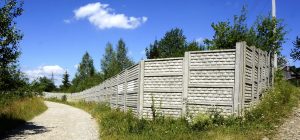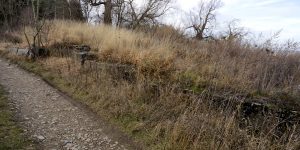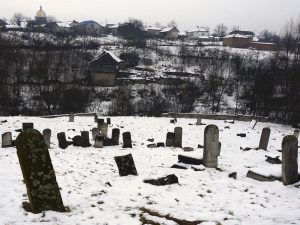![]() Ця сторінка також доступна українською.
Ця сторінка також доступна українською.
Introduction
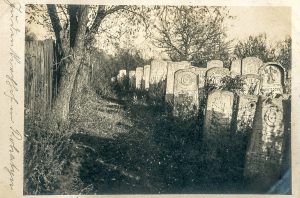
The old Jewish cemetery of Rohatyn ca. WWI. To the left, a rough wooden picket fence marks the northern boundary. Image courtesy Tomasz Wiśniewski.
Fences and walls are erected around some Jewish cemeteries (and much less often, around Jewish mass graves) for a variety of reasons. This guide page presents an overview of issues and questions to be considered when choosing a strategy for marking and/or protecting a cemetery perimeter as well as some practical guidance and contacts for organizations which can help. A very informative example project with a mixture of issues and solutions is shown in case study 12 on this website, and images and details of other projects are included here to provide useful comparisons. We do not promote a single approach to serve all Jewish burial sites in western Ukraine, or detailed instructions for laying out and constructing fences, walls, and gates. However, a number of print and digital references relevant to wall and fence construction have been linked in the resources section on this website to support both conceptual and detailed design and construction.
In English, the terms “wall” and “fence” are used somewhat interchangeably, and for most of the topics on this page the discussion is applicable to both. Where a distinction is made, typically a wall has a solid foundation along its entire length supporting the barrier mass, while the infill of a fence is typically supported on discrete, spaced posts which are most often individually embedded in footings in the soil, but may be supported on a foundation which can also serve as a retaining wall for sloping ground.
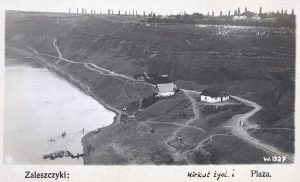
The large Jewish cemetery of Zalishchyky (Ternopil oblast), unfenced in 1927. Source: Polona.
Evidence in historical photographs shows that some Jewish cemeteries in western Ukraine were at least partially fenced well before World War II. After the war, and especially since Ukraine’s independence, some old stone walls have been repaired and some new walls and fences have been built, though older fences and walls continue to decay and disappear. From a comprehensive survey between 2018 and 2020 of the roughly 1000 prewar Jewish cemeteries across Ukraine by ESJF European Jewish Cemeteries Initiative, analysis shows that there are intact walls or fences at about 43% of the cemeteries which have not been destroyed and overbuilt. The percentage of fenced cemeteries in western Ukraine is lower than the national average. Analyzing ESJF’s regional data shows just over 38% of the more than 200 extant Jewish cemeteries in Lviv, Ivano-Frankivsk, and Ternopil oblasts are fenced, as of 2020. Fencing is particularly rare in Lviv oblast, in which only 31% of extant Jewish cemeteries have perimeter marking and protection, and more than 60% of prewar Jewish cemeteries are now either erased of any sign of their Jewish community history, or have been overbuilt (and lost).

Installation of the poured concrete wall around the Jewish cemetery in Bolekhiv. Images © HFPJC.
New fencing projects are often funded in part or fully by Jewish descendants together with other commemorative work (for example at Nadvirna, Bolekhiv, and Rohatyn, all in Ivano-Frankivsk oblast), and sometimes by individual families of prominent Jewish former residents (for example at Yahilnytsia in Ternopil oblast), though the practical work to design and construct fences and walls is almost always done by regional building contractors, including both Jewish non-profit and non-Jewish commercial organizations.
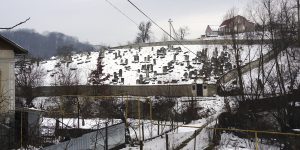
A view of the perimeter wall and gate at the Jewish cemetery of Skala-Podilska (Ternopil oblast). Photo © RJH.
Construction of a fence or more massive wall should proceed only after several other phases of project work have progressed or completed, as outlined on this website. A preliminary assessment of the site involving a walkover review is of course essential, but it is likely that an accurate and detailed ground survey of the site is also needed, including landscape boundaries and fixed objects (matzevot and other markers, utility poles, etc.) plus any nearby roads and existing walking paths through the site; a legal review may also be required. Wild vegetation may need to be cut and cleared before conducting the ground survey, and especially before laying out the fence lines. As for any substantial construction at a burial site, the design and installation should be guided by an overall project concept which incorporates the ground survey results as well as commemorative and security aspects, and considers sustainability, i.e. the predicted longevity of the fence or wall and its long-term maintenance during decades of exposure to the elements. Fence and wall construction is usually costly, so the concept and plans should also incorporate overall and detailed budgets which support feasible fundraising.
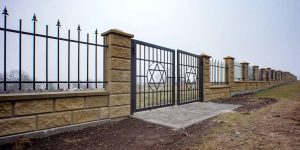
A new fence and decorative gate at the Jewish cemetery in Tovste (Ternopil oblast). Image © ESJF.
On this page we begin by discussing the intended and unintended effects of different types of barriers on the boundaries of Jewish burial sites in western Ukraine. We then link to some useful regional and international resources for the design, funding, and construction of fences, walls, and gates; the websites of some of those organizations can also serve as galleries of reference designs for inspiration and for practical planning and cost estimates. In addition, we outline some common structural and aesthetic styles, materials, and construction, and then evaluate a number of existing regional Jewish cemetery walls and fences to discuss the durability and expected lifespan of new construction, with and without maintenance. As for any project which involves physical intervention at a burial site, research and caution are advised before any tools are brought to bear on the planned work.
The Function and Meaning of Walls and Fences
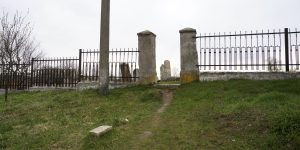
Open fencing visually marks the Jewish cemetery of Pidhaitsi (Ternopil oblast) without obstructing it. Photo © RJH.
Marking the perimeter of Jewish cemeteries is an ancient tradition, to warn Jewish passersby that within the marked boundaries lies a space considered impure (because of the dead who are interred there). Visitors to Jewish cemeteries wash their hands as they depart, in a symbolic and practical gesture which acknowledges the concurrent holy and impure nature of burial grounds. Open fencing, a continuous hedge, or even merely a row of rocks, posts, shrubs, or trees can provide a visual marker of cemetery boundaries, creating awareness and common knowledge about the ongoing rightful usage of the space, while allowing people and wildlife to pass through where there are customary paths. Identification and information signage can significantly amplify the signaling function of boundary markers within the local community and for visitors to the cemetery or mass grave.
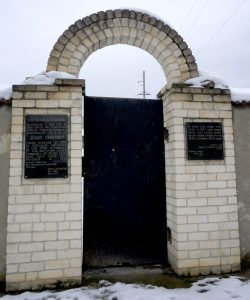
The locked gate at the Jewish cemetery in Skala-Podilska (Ternopil oblast). Signs in three languages give some history but no guidance for how visitors can get access. Photo © RJH.
Erecting closed walls as protection for Jewish cemeteries dates at least from the Middle Ages in Europe, and many Jewish and Christian cemeteries are walled today. The security provided by a wall is imperfect; some walls are easily scaled by children and adults, and no barrier will stop a determined thief or vandal. In his short story, “The Great Wall of China”, the Bohemian Jewish writer Franz Kafka said “Human nature, which is fundamentally careless and by nature like the whirling dust, endures no restraint.” A high and opaque wall may even encourage illicit activity within a remote cemetery or at night, by shielding the activity from view. Paneled sections of fences and most walls can provide a kind of exhibition space for information signage, or a base for mounting headstone fragments as a memorial, but also create blank canvases which can attract graffiti.
High fences, walls, and locked gates can create other conflicts for both local people and occasional visitors as well. The American poet Robert Frost wrote:
Before I built a wall I’d ask to know
What I was walling in or walling out,
And to whom I was like to give offense.
Something there is that doesn’t love a wall,
That wants it down.
[Robert Frost, “Mending Wall”, from “North of Boston”, 1914]
In the absence of discussion with the local community, new walls or fencing may cause disputes if the barrier shuts off pathways which have crossed the space since before or after burials ceased at a cemetery, and if no reasonable accommodation can be found. Jewish and other benign visitors to the cemetery may be thwarted by a locked gate, if there is no posted notice for how to locate the key, or if the keyholder does not share a language with the visitors. Without assured key access, locked gates will also prevent employees of the municipal administration and volunteers with local service organizations from managing wild vegetation within the cemetery or mass grave site. Each of these potential issues should be considered in any new fence or wall concept, to enable decisions based on tradeoffs and adaptation to local concerns.
Skilled Design and Construction Resources in Western Ukraine
A few Jewish heritage organizations have already been actively installing fences and walls around Jewish cemeteries in western Ukraine in the past decade. The design and construction work can also be capably managed by experienced organizations which have not previously worked at Jewish heritage sites, provided that the project lead makes them aware of halakha and traditional rules of respect about working at Jewish burial grounds. Here are a few well-documented organizations with the relevant experience:
ESJF European Jewish Cemeteries Initiative:
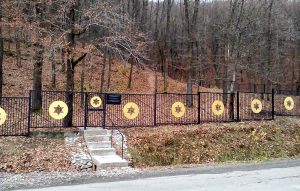
A decorative steel fence installed by ESJF at the Jewish cemetery of Lypcha (Zakarpattia oblast). Image © ESJF.
Since 2015 ESJF European Jewish Cemeteries Initiative (ESJF) has surveyed, engineered, and erected walls or fences around well over 100 Jewish cemeteries in Europe, about two thirds of which are in Ukraine. About fifteen of the protected cemeteries are in the region we define as western Ukraine (Lviv, Ternopil, and Ivano-Frankivsk oblasts), with more than 60 others in the oblasts of Zakarpattia and Chernivtsi. The organization has surveyed nearly every Jewish cemetery across western Ukraine (and 99% of verified cemeteries in Ukraine), gathering landscape dimensions and other data to enable designs, plans, and cost estimates for perimeter fences or walls, and enabling statistical analysis to place individual projects in context of regions and all of Ukraine. Browsing the summaries of completed projects on the ESJF website or their pdf catalogue of projects for 2015-2017 can help project activists to quickly select one or more preferred styles from a wide variety of examples for further discussion. ESJF has also produced a brief video summarizing a complex and multi-faceted fencing project they completed in 2017 at the huge Kremenets Jewish cemetery in Ternopil oblast, which shows several different types of fencing strategies to cope with steep terrain and other challenges.
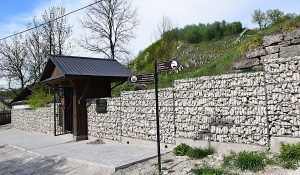
A gabion retaining wall installed at the Jewish cemetery of Kremenets (Ternopil oblast). Image © ESJF.
For engineering and construction plans, ESJF works under the supervision of a rabbinical board to maintain compliance with halakha and Jewish burial site traditions. Although originally most costs for Jewish cemetery fences and walls were paid by ESJF out of a grant provided by the Federal Republic of Germany, to extend the design and construction resources to a greater number of sites, ESJF now often partners with Jewish descendants’ organizations and other separate funding sources (including Geder Avos, see below) for the construction materials and labor to complete the projects. As part of their work to broaden the protection and promotion of Jewish burial sites in Europe, in recent years ESJF has created educational materials for secondary schools and museums, arranged and conducted vegetation clearing projects before and after fencing, conducted tailored university-level training seminars on surveying methods and on the role of Jewish cemeteries as shared heritage in modern society, and constructed memorial monuments at Jewish mass grave sites from the Holocaust. ESJF’s contact information is on their website.

Three types of enclosures engineered by ESJF for the new Jewish cemetery in Sniatyn (Ivano-Frankivsk oblast). Images © ESJF.
Heritage Foundation for Preservation of Jewish Cemeteries (HFPJC):
Founded in 2002, the Heritage Foundation for Preservation of Jewish Cemeteries (HFPJC, also known as Avoyseinu) surveys and assesses Jewish cemeteries in nine countries of central and eastern Europe, then conducts projects at the sites to address the most significant needs for rehabilitation and preservation. The organization emphasizes long-term maintenance, often through the local communities, to help the site work endure. HFPJC cemetery work usually includes erecting a sectional concrete wall at the perimeter, but can also include clearing vegetation, building or repairing ohels, resetting headstones (often in poured concrete bases), and photographing headstones to document inscribed epitaphs. At a few sites, HFPJC has installed metal fencing instead of concrete walls, or structural retaining walls with gabion assemblies or other materials. All plans and site work are performed with rabbinical oversight.
HFPJC has completed surveys and construction at more than 300 Jewish cemeteries in Europe (particularly in Hungary and other regions of the former Kingdom of Hungary), including more than 40 wall projects in Ukraine. Of these, only 7 wall projects to date have been in western Ukraine (defined here as the Lviv, Ternopil, and Ivano-Frankivsk oblasts), but 28 perimeter walls have been erected around Jewish cemeteries in nearby Zakarpattia oblast. Headstone resetting and other non-wall projects have also primarily been in Zakarpattia oblast, but one resetting project has been in progress at the Jewish cemetery of Rozdil in Lviv oblast, and HFPJC placed a memorial monument at the largely destroyed old Jewish cemetery in Brody, also in Lviv oblast. in addition to the completed projects, more than 60 other projects in Ukraine are in various stages of inquiry, evaluation, or planning. Contact information and a query form are available on their website.

Documentation by HFPJC of their fence installation work at the Jewish cemetery in Deliatyn (Ivano-Frankivsk oblast). Images © HFPJC.
Geder Avos (with Oholei Tzadikim and others):
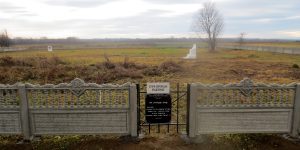
A concrete panel fence installed by Geder Avos at the Jewish cemetery of Velyki Didushychi (Lviv oblast).
Image © Geder Avos.
The non-profit organization Geder Avos aims to preserve Jewish heritage by restoring and maintaining Jewish burial sites (both cemeteries and mass graves) in eastern Europe. Most of their cemetery efforts are focused on repairing and rebuilding ohels over the graves of historically significant tzadikim; some of their projects include funding for vegetation clearing, site rehabilitation, headstone repair, and the construction of walls and gates around the cemetery perimeter. At mass graves, Geder Avos organizes and funds research as well as the construction of protective covers and the erection of commemorative monuments.
The Geder Avos website documents about 50 completed projects, more than 80% of them in Ukraine. Of these, about 20 were in western Ukraine (Lviv, Ternopil, and Ivano-Frankivsk oblasts), including 13 wall and fence projects, usually one of the major funding resources for joint efforts coordinated with Rabbi Israel Meir Gabay of the Oholei Tzadikim, and with ESJF and HFPJC. An additional three wall and fence projects have been completed to date in the adjacent Chernivtsi and Zakarpattia oblasts. Contact information for Geder Avos is on their website.

A concrete panel fence installed by Geder Avos at the Jewish cemetery of Yahilnytsia (Ternopil oblast). Images © Geder Avos.
Faina Petryakova Scientific Center for Judaica and Jewish Art:
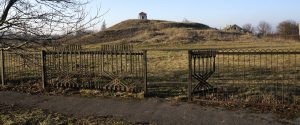
One of the Center’s fencing projects at the new Jewish cemetery in Olesko (Lviv oblast). Photo © RJH
The Faina Petryakova Scientific Center for Judaica and Jewish Art serves as the public face of a Lviv-based organization which for more than three decades has worked to preserve Jewish heritage, especially cemeteries and mass graves, across the western half of Ukraine. Managed by Meylakh Sheykhet, who also serves as Director of the Ukraine Bureau for the Washington DC-based Union of Councils for Jews in the Former Soviet Union (UCSJ), their efforts include research (both legal and ground survey) as well as design and construction of access, fences, and ohels at cemeteries plus headstone recovery and other related work. Ground-level construction work at burial sites is supervised by religiously-trained leaders.
Although the Center’s website does not enable accounting or statistics of their past fencing work, area surveys for this research project have noted several cemeteries with sturdy iron fences and gates in western Ukraine, such as at Radekhiv and Olesko in Lviv oblast, and at Stratyn in Ivano-Frankivsk oblast. Contact information for the Center is on their website.
Municipalities and Other Regional Engineering and Construction Contractors:
Substantial walls and fences erected around cemeteries often require review and approval by local municipal administrations or village councils, and in some cases the civic authorities will want to participate in the design and construction work of perimeter marking and protection of Jewish cemeteries as part of their responsibility to care for regional burial sites.
Because new wall and fence construction inevitably involves some excavation, cemetery project leaders should always engage a regional rabbi or other Jewish religious leader to review the site, survey data, and plans before purchasing materials and beginning work. With advice and oversight, experienced local building contractors can design and erect fences and walls of any style, and will often know the best sources for preferred materials and labor in the local area. Involving the civic authorities, cemetery neighbors, as well as local craftspeople and businesses in the work can help create pride in the shared heritage of the community and facilitate arrangements for long-term maintenance of the new construction and the site overall. Each of the Jewish organizations described above note the importance of agreements and/or contracts to sustain fences and walls in the future; this topic is also emphasized below.
Styles, Materials, and Construction
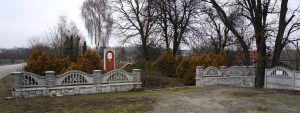
Decorative stone and precast concrete panel fence at the new Jewish cemetery and mass grave site in Lanivtsi (Ternopil oblast). Photo © RJH.
Cemetery preservation project leaders who do not have experience building fences or walls in western Ukraine are advised to work with experienced professionals such as those listed above for the design and construction of suitable perimeter marking and protection. However, even for those who will do no hands-on work on the project, it is helpful to see and evaluate alternatives through galleries of images and by visiting sites in the region and abroad. Each of the primary Jewish cemetery organizations linked above has documented their projects online with photos; we especially recommend the ESJF cemeteries series in Ukraine because of the large number and wide variety of built enclosures, but images posted by all of the organizations can help guide new projects.
For those planning their own designs, or simply wanting to understand the possible styles, materials, and construction methods for fences, walls, and gates, there are many practical books, articles, and videos available, several of which are available online for free, including older but still valuable illustrated books which have been scanned and posted for library-style borrowing on the Internet Archive. Many of these references are written for homeowners, i.e. for smaller-scale projects than typical cemetery enclosures, but the materials, tools, process, and issues are the same regardless of fence or wall length.
As described in these references, considerations in enclosure design include:
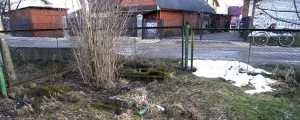
Simple chain-link fencing at the Jewish cemetery in Perehinske (Ivano-Frankivsk oblast). Photo © RJH.
Styles:
- opacity: open, partially open, or solid
- height: above eye level or below
- support: continuous foundation or spaced footings
- aesthetics: “good” face inside, outside, or both
- gates: number, placement, size, paths and stairs, opening direction, latches, locks
Materials:
- wood: rail, picket, louver, panel, bentwood/twigwork, palisade/paling, grapestake, board, panel, basketweave
- metal: wire, stamped steel or aluminum, wrought iron, chain link
- masonry: drystone, brick, mortared stone, concrete block, poured & reinforced concrete
- hybrid: gabion, mixed stone or concrete and iron
- living: hedges, trees and trellis, vides and rails
- finishes: plastering stucco, veneering stone, paint, stain, rust inhibitors at joints, gate hinge lubricants
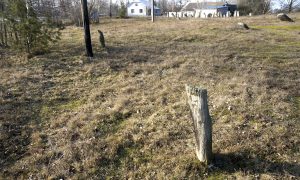
Only the posts remain from a prewar wooden fence at the Jewish cemetery in Stanislavchyk (Lviv oblast). Photo © RJH.
Construction:
- footings and foundations: depth, excavation, reinforcement, water drainage
- post-and-rail: drained concrete footings, decay-resistant posts, infill spacing or overlap
- continuous wall: trenching and forms, drained reinforced concrete base
- level and square: effects of plumb installation on aesthetics and durability
Cost, including installation:
- very low cost for basic perimeter marking with no barrier function
- about US$50 per meter for light wire or picket fences, US$80~200 per meter for aesthetic stone and wrought iron fences
- about US$50 per meter for hollow concrete block or precast concrete panel walls; can be much higher cost for heavier steel-reinforced concrete walls
- gate costs vary widely depending on materials and construction
- site clearing and surveying prior to design and construction also add to fence and wall project costs; see the case studies for these phases for estimates of those costs
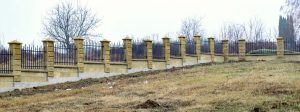
Managing ground slope at the Jewish cemetery fence line in Tovste. Image © ESJF.
Issues:
- ground slope at the perimeter: some enclosure styles adapt easily, others not well at all
- retaining walls: to hold steeply-sloped ground in place
- anti-climbing: no toe holds (openings less than 5cm)
- signage: identification, cultural/historical info, contact info
- maintenance: budgets, agreements, contracts
Hand sketches or common design tools and software can aid all phases of the project from concept to design and costing. Studying the basic anatomy of a fence can be a helpful starting point.
Repair, Maintenance, and the Longevity of a Fence or Wall
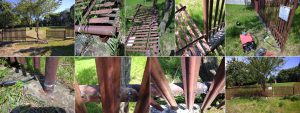
Welding and other repairs to a broken 20-year-old fence and gate at the new Jewish cemetery of Rohatyn. Photos © RJH.
Pre-project research which reviews existing fences, walls, and gates will quickly surface a consistent issue: nearly every enclosure built around cemeteries and other spaces exhibits some signs of decay, even those built within the past decade, and some structures are noticeably tilted or falling down. Even where there has been no human action to breach the barriers, weather and related ground subsidence are sufficient to limit the life of any “permanent” installation. The durability of various design and construction options should be considered as part of project concepts, and at least an estimate should be made of the anticipated longevity of alternative fences and walls, with and without maintenance. This is particularly important for projects which will proceed without the participation of the local residential and civic community. See the guide page for sustainability planning for a wide range of general information on this topic.
A well-built wall with a deep and substantial foundation and a crown which properly sheds water should last for many decades in the typical weather in western Ukraine, though the facing materials may occasionally need to be repaired or replaced. Even if no “shortcuts” are made in materials and ground preparation, lighter-weight fences generally require more frequent inspection and maintenance: scraping and new paint or stain for both wooden and metal fences, and renewal of rust inhibitors at metal joints unless stainless steel or aluminum fasteners are used. Based on observations in the region, well-built fences will typically last only about two decades without substantial renewal, or perhaps three decades before they decay to a point where they can no longer be repaired and must be replaced. Wire fences, including gabion stone cages, are prone to relatively rapid deterioration and failure unless the wire material is especially corrosion resistant. Evidence at Jewish cemeteries shows that gates are usually the first perimeter feature to substantially fail, typically sagging to the point where they no longer open or close, or with stuck or broken hinges and latches. In addition to weather-related decay, fences made with panels or pickets of metal are also susceptible to theft of sections for reuse elsewhere and for recycling value. The durability of a burial site enclosure must be emphasized during concept, design, and construction phases, and maintenance and eventual replacement of the fence, wall, and gates should be part of the overall project budget.

Two intact 7-arm decorative metal menorahs plus eight broken examples at the old Jewish cemetery in Brody (Lviv oblast). Photos © RJH.



